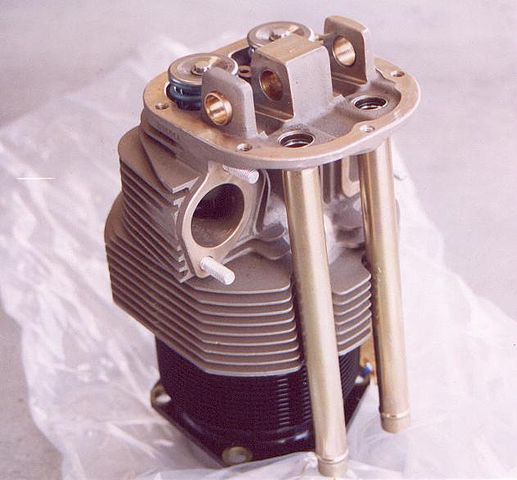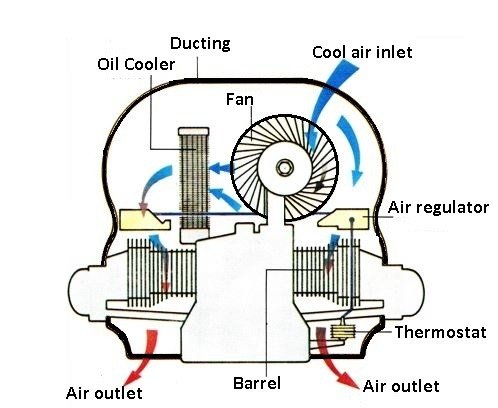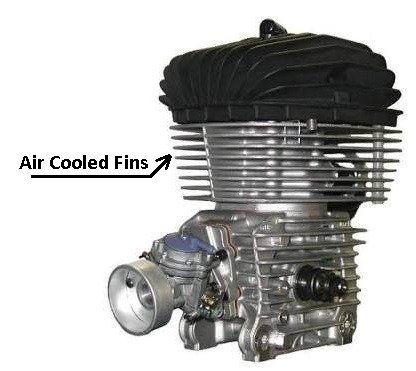In this article, you will learn what is air cooling system and how it works? Their advantages and disadvantages are all explained with Pictures.
If you need a PDF file, download it at the end of the article.
What is an Air Cooling System?

In the air cooling system, the heat is dissipated directly to the air after being conducted through the cylinder walls. Air cooling systems have fins and flanges on the outer surfaces of the cylinders. The heads serve to increase the area exposed to the cooling air, and so raise the rate of cooling.
The basic principle involved in this method is to have a current of air flowing continuously over the heated surface of the engine from where the heat is to be removed. The amount of heat dissipated is based on the following factors.
- The surface area of metal in contact with air.
- The rate of airflow.
- A temperature difference between the heated surface and the air.
- The conductivity of the metal.
For complete use of air-cooling, the surface area of the metal that comes in contact with air is improved by providing fins over the cylinder barrels. The more the surface area in contact with air, the more the heat is dissipated. The higher the rate of airflow, the higher the heat is dissipated.
Similarly higher the temperature difference between the heated surface and the air, the higher the heat dissipation. A metal having conductivity dissipates more amount of heat.
Read Also: 25 Car Dashboard Warning Lights and Indicators [Explained]
Components of Air-Cooled Engines
The components of most air-cooling systems are very simple.

The cooling fan is placed in a semicircular duct. The ducting covers the cylinder head. Its interior is fitted with baffles that direct airflow over the engine cooling fins and through an oil cooler. Below the cylinders, the air is delivered over a thermostat, which operates a valve via a lever.
The valve controls the amount of air reaching the fan, thus maintaining the correct engine temperature. After passing over the engine and thermostat, the air is forced out of the rear of the car or passed through a heat transfer system that supplies hot water to the car’s heater.
One problem connected with the use of air-cooled engines is the requirement of enough heating and demisting systems for the car.
Water-cooled engines always have a constant supply of hot water and it is easy enough to convert this into hot air. Air-cooled engines usually have an independent heater or harness the heat of the exhaust system.
Some older models have heating systems that combine both of these methods. An electrically operated heater that burns petrol supplies hot air to the car interior by way of a blower fan.
The same fan fed the hot air from the heat exchangers, which were finned alloy castings on the exhaust system. Hot air was fed into a mixer chamber, where it was blended with fresh air to give a controlled amount of heat.
Cooling Fins

The surface area over the cylinder gets bigger using fins. These fins are either cast as an essential part of the cylinder or different finned barrels are placed over the cylinder barrel. Sometimes particularly in aero engines, the fins are machined from the forged cylinder blanks.
As a rule, the fins are usually made of about the cylinder wall thickness at their roots, tapering down to about one-half the root thickness. The length of the fins varies from one-quarter to one-third of the cylinder diameter.
The distance between the two fin centers is about one-quarter to one-third of their length. The total length of the finned cylinder barrel is from 1 to 1½ times the cylinder bore.
Another rule based upon experimental considerations is to allow 1400 to 2400 cm² of cooling fin area per horsepower. This gives about the correct cylinder temperature at 50 to 70 km/hr airspeed.
Fan Cooling
Fan cooling is used in larger air-cooled engines, particularly in cars. A fan, having two or four blades, is driven either at engine speed or twice the engine’s speed, and the airflow is directed in the cylinder heads. The cooling depends chiefly upon the engine speed and not upon the forward speed of the car. The fan usually absorbs about H.P. for every 15 to 20 H.P. output.
In the case of small single-cylinder engines, an excellent arrangement of fan cooling is a fan of about flywheel diameter. The fan is mounted on the main shaft and enclosed in a metal casing. So arranged that the air is drawn in at the center and expelled peripherally through a belt-mounted duct directing it onto the exhaust side of the cylinder.
In small air-cooled engines, the blower-type fan works quite well, if suitable guides and ducts are provided for the air streams. The system is also used for the larger engine. With the cooling system on the suction side of the fan, a more satisfactory cooling effect is obtained.
Sometimes, the flywheel itself is tightened to function as a cooling fan. And the air is discharged backward through it, after having been drawn past the cylinder barrels.
In Fiat and Corvair engines, the quality of cooling air is regulated thermostatically. When the temperature of the air discharged from the cylinder increases above the normal value, the thermostat actuates a larger valve, or disc in the air outlet duct to allow a greater quality of air to flow.
Read Also: What are the Types of Transmission Systems Used In Vehicle?
Advantages of Air Cooling System Engine
- Lighter in weight due to there being no radiator, cooling jackets and coolant.
- No topping up the cooling system
- No leaks to guard against.
- Anti-freeze is not required.
- The engine warms up faster than with a water-cooled design.
- This system can work in cold climates where water may freeze.
- Can be used in areas where there is a scarcity of cooling water.
Disadvantages of Air Cooling System Engine
- Less efficient cooling system, because the coefficient of heat transfer for air is less than that for water.
- It is not easy to maintain even cool around the cylinder, the cylinder deformation can occur.
- More noisy operation.
- Limited use in motorcycles, and scooters where the cylinders are exposed to the air stream.
Example Of Air Cooling System in Engines
At present, air cooling is used on engines ex. like scooters, motorcycles, airplanes, combat tanks, and small stationary installations. And in many models of an American rear-engine car. In Germany, air cooling is used in some petrol and C.I. engines including 2, 4 and 8 cylinder models.
A good example of the modern air-cooled type is the Krupp four-cylinder opposed compression ignition engine. This has a cooling fan fitted at the front end and is driven by the engine.
It forced the cooling air through a casing around the front end of the crankcase and hence to the horizontal cylinder barrels which are ribbed and enclosed in a rectangular casing.
Another more recent example is the Krupp eight-cylinder V-type petrol engine, Which has a very similar cooling arrangement.
The Volkswagon, Dutch D.A.F. Citroen-two-cylinder opposed. Chevrolet Corvair six-cylinder horizontally opposed, fiat 500D, two cylinders in line. And N.S.U. two cylinders are examples of modern air-cooled engines.
Conclusion
That’s it. Thanks for reading. If you have any doubt or any questions about the “air cooling system” tell us in the comments. If you need help contact us. Share this article with your friends if you find this helpful.
Want free PDFs direct to your inbox? Then subscribe to our newsletter.
Download PDF of this article:
Read more topics like this:
- Types of Car Sensors and Their Functions
- Difference Between Petrol and Diesel Engines Explained
- How Does An Electric Power Steering Work?
FAQs
The heat in the air conditioning system is transferred through the cylinder walls and then released straight into the air. The outside surfaces of the cylinders in air cooling systems are equipped with fins and flanges.
Air-cooled engines use direct air circulation over heat-dissipation fins or hot sections of the engine to cool them and keep the engine functioning at the proper temperature.
The air cooling system is generally constructed of important parts such as a thermostat, radiator, water pump, freeze plugs, cooling fan, heater core, hoses, etc.
There are no coolant leak issues with air-cooled engines. As a result of having fewer parts, they are typically lighter than liquid-cooled engines.
Great summary need a PDF file
The PDF file has been sent to your inbox.
Very good bag study very very useful
Thanks for your feedback.